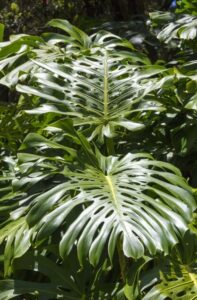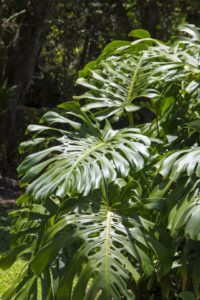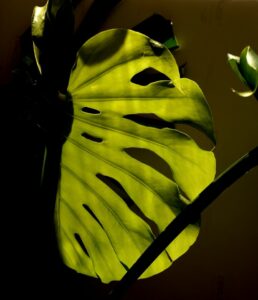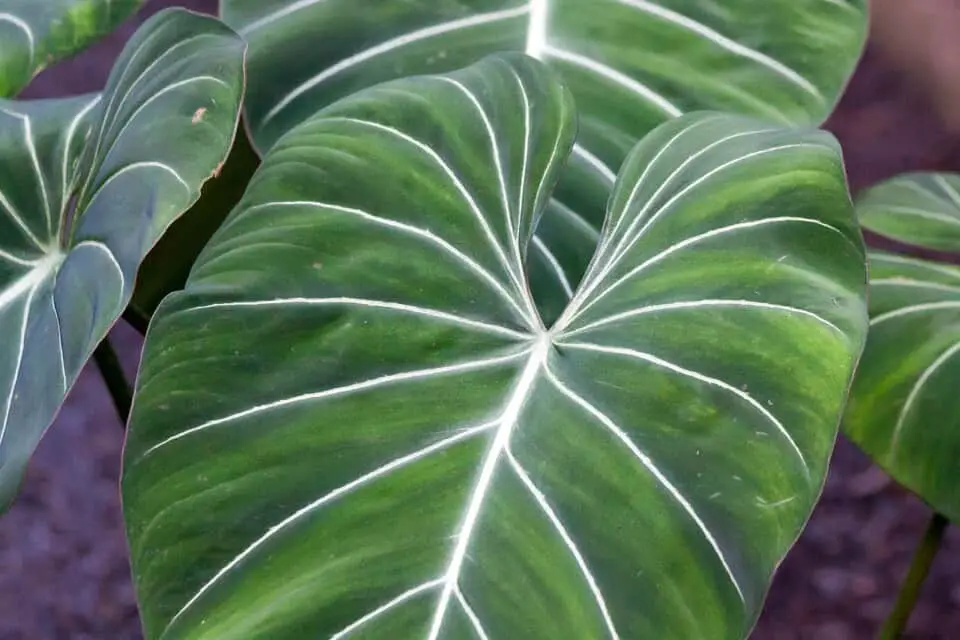Some links in the post are affiliate links and I get a commission from purchases made through some links found in the post.
When I first set my eyes on the large, green, and glossy leaves on the philodendron, I knew that I had to have one.
So, I headed to the nursery to choose the species that would bring out the beauty in my home. But I had one main concern – I could not plant the philodendron outside, but my indoors was not the brightest.
Like you, I wondered whether my philodendron could keep up with the partial shade in my home. Could it?
A philodendron grows best in partial shade! The philodendron, which comes in vining and non-climbing species, can tolerate shade but prefers partial shade.
It grows among foliage in its native regions where it has access to indirect sunlight. But the answer to the light needs is a bit more complicated than this because it depends on the type of philodendron you take home.
This guide takes you through which philodendrons can grow in the shade and how to provide your plant with its most essential needs. Let’s get into it:
Can Philodendrons Grow in Shade?
 If you look up the philodendron, you soon come to realize that it’s a genus. That means that it gives way to hundreds of species, which go by the name philodendron.
If you look up the philodendron, you soon come to realize that it’s a genus. That means that it gives way to hundreds of species, which go by the name philodendron.
Did you know that? And as you get to know each of these species, you start to notice that their light needs are different.
What do I mean by this? Generally, the term philodendron refers to perennial species under the Araceae family.
These plants grow to heights of one to twenty feet in the wild and can be as wide as 6 feet in the right conditions.
And for the most part, these plants do well in partial shade – having become accustomed to filtered light in the forests and other natural habitats.
Oh, and they mainly do well in zones 9 to 11 in the USA (which you can adjust to find what works best in your region).
Up to that point, it would seem like any philodendron would be okay with living in the shade. But that’s where it gets a bit complex.
Each philodendron comes with its preferred set of light conditions. How so? The general philodendron can persevere some shade and enjoys partial/ filtered light.
For such a plant, any position near a window would be good, provided that the plant receives bright and indirect light.
In direct sunlight, the leaves show signs of yellowing which takes away from their glossy green hue.
And in shaded conditions, the philodendron starts exhibiting leggy growth with a less bushy appeal. But like we said, lighting depends on the species.
Take the philodendron shrub as an example. This plant, which also does best in zones 9 to 11 in the USA, prefers some sun.
You can shade it for a while when the temperatures get intense, but for the most part, it prefers light. However, it can tolerate shade to a great extent. As such, it is often a good choice for landscaping.
Now, let’s consider the vining Philodendron Erubescens. This plant exhibits redness in its new foliage and shows color even in its mature leaves.
And if you get a hybrid, you can enjoy an array of hues that are sure to bring out its beauty.
But without access to bright light, this plant will not thrive, and you cannot enjoy its colors. As such, this plant cannot withstand prolonged exposure to shade.
See? Each philodendron is subject to its set of rules. Thus, to answer the question, a general philodendron with no special needs can do well in the shade.
But in most cases, the plant needs access to bright and indirect light, while some species actually prefer the outdoor light exposure. Let’s look at some varieties that like being in the shade.
If you’re enjoying this article, check out our article on how to propagate philodendrons in water.
What Varieties of Philodendron Like Growing in Shade?
When I realized that philodendron was a naming word for hundreds of species, I knew I had to understand which species could thrive in my shaded house.
But before we get into which varieties can do well in the shade, let me break down the types of shade:
- Dense Shade: This is shade under manmade structures,
- Full Shade: This is a dense shade with sunlight exposure <3 hours a day,
- Light Shade: This shade is also known as dappled shade and occurs under tall vegetation, and
- Partial Shade: This is a shade with sunlight exposure of 3 to 6 hours a day. It is also known as partial sun.
So, which shade are we talking about in this case? – Light shade. This type of shade does not receive enough sunlight but still gets enough light to sustain plant growth. Even so, the plants in such shade do not have full sun exposure.
Which plants can thrive in such shade?
1) The Heart Leaf Philodendron
 This plant, also known as the Philodendron Scandens, is one of the most common philodendrons.
This plant, also known as the Philodendron Scandens, is one of the most common philodendrons.
After all, most gardeners claim it is harder to kill than keep. And you know what that means – maintenance is a breeze.
Besides its easy maintenance, this plant also boasts aesthetic value due to its heart-shaped leaves. Who would not want that in their home?
The Philodendron hederaceum and Philodendron cordatum species also bear a close resemblance to it.
It helps to point out that many philodendron species have heart-shaped leaves. So, in this case, our focus is on the scandens whose shape is more pronounced.
It does best in indirect sun. You can also place it in a place with bright sunlight, ensuring that the plant does not get into contact with direct sunlight.
2) The Moonlight Philodendron
One thing I love about hybrids is that they adjust to indoor conditions quite well. And with the moonlight species being a hybrid, its growing conditions are pretty attainable.
It features light green (almost like lime) leaves with smooth surfaces that light up the room. So, if you are in the market for something that will inspire some awe, this plant is a good choice.
I should add that the leaves will not always be a light green. As the plant matures, they will take on a darker green shade that is still sure to make your room look alive.
It does best in the shade, making it an excellent choice for any home where access to light might be an issue. You can place it near a window to provide it with shade, ensuring that it does not get directly exposed to the sun.
3) The Philodendron Gloriosum
How would you like some large foliage in your home? This plant boasts large leaves with a velvety feel coupled with a lovely green hue.
Oh, and its veins have an off-white shade that contrasts with the green in their leaves. The result? – A plant that will also serve as a work of art in the home. But can it withstand shade?
Sure, it can! This plant does best when left in a spot with bright but indirect light. And by now, you have already figured out that one of the best spots is by the window.
Ensure that the sun will not get to the plant, and your work will be as good as done. If it gets in touch with the sun, its leaves will burn and curl, which will be the end of their allure.
So, you cannot take this requirement lightly. But if you give them what they want, they will thrive. And since they are vining plants, they will spread in the house, and you can direct them as you please.
4) The Philodendron Birkin
Pinstripes look great – on suits, wallpapers, art décor, etc. But have you ever seen them adorn a plant? That’s right! This species features large green leaves with white lines running across the surface.
This aesthetic is enough to transform any space from bland to fascinating. And to make things even better, the leaf patterns are not always the same – like marble. So, you can get a different aesthetic from each leaf, creating a lovely picture.
Does the plant do well in the shade? Yes! But it does not like dark shade. Instead, it prefers partial shade – access to bright and indirect light. And it also does not like exposure to full sunlight.
You may also like: Can a philodendron be put outside
More Philodendrons that Grow well in Shade
Are you curious about other philodendron species that can survive such conditions? The list goes on:
- The Philodendron Micans,
- The Philodendron Pink Princess,
- The Xanadu Philodendron,
- The Split Leaf Philodendron, and
- The Philodendron Hope.
 As much as all these philodendron species can thrive in the shade, you should still provide them with access to bright indirect light.
As much as all these philodendron species can thrive in the shade, you should still provide them with access to bright indirect light.
Otherwise, the color in their leaves will start to fade, and their aesthetic appeal will take a hit. So, while they might not die from the shade, they could start looking weak and discolored.
If you want to plant a philodendron in your home, you should assess the amount of light you get. Moreover, you should look into the type of shade you can provide the plant.
Some philodendrons do best in partial shade, while others tolerate more shade. Be sure to check your species’ exact requirements as there are hundreds of philodendrons in the market with different needs.
Happy Gardening!
Before you go, here are some more related articles I encourage you to read below to help solve more of your gardening issues:
What is the rarest philodendron


